An Overview of Pros and Cons of Zipper Braced Frames
A. Mirza Gol Tabar Roshan1 and R. Nodeh Farahoni2 *
1
Civil Engineering Faculty,
Babol Noshirvani University of Technology,
Babol,
Iran
2
Structural Engineering,
Babol Noshirvani University of Technology,
Babol,
Iran
DOI: http://dx.doi.org/10.12944/CWE.10.Special-Issue1.15
The chevron bracing system provides the highest level of stiffness and average ductility by using the yield or buckling of braces. This system demonstrates weak post-buckling behavior while other structural members such as beams, columns and joints show elastic behavior. As a result of bracing buckling at a story, the unbalancing force acts perpendicular on the middle of the beam span and results in the concentration of damage on that story. Consequently, the affected story becomes prone to the soft story mechanism and the structure collapses eventually. In order to prevent this problem, it is possible to place vertical elements (zippers) between beams so that the head of bracings are connected at height and the resulting unbalancing force in the story is transferred to upper stories. Such a frame is known as the zipper frame. With a proper zipper configuration, it is possible to address the problems and weaknesses of the chevron bracing frame. Therefore, zipper frames can become proper substitutes for this type of bracing systems. By using the chevron element in the chevron bracing and turning it into a zipper frame, it is possible to increase the strength, ductility and energy absorption capacity of such frames.
Copy the following to cite this article:
Roshan A. M. G. T, Farahoni R. N. An Overview of Pros and Cons of Zipper Braced Frames. Special Issue of Curr World Environ 2015;10(Special Issue May 2015). DOI:http://dx.doi.org/10.12944/CWE.10.Special-Issue1.15
Copy the following to cite this URL:
Roshan A. M. G. T, Farahoni R. N. An Overview of Pros and Cons of Zipper Braced Frames. Special Issue of Curr World Environ 2015;10(Special Issue May 2015). Available from: http://www.cwejournal.org/?p=10440
Download article (pdf)
Citation Manager
Publish History
Select type of program for download
| Endnote EndNote format (Mac & Win) | |
| Reference Manager Ris format (Win only) | |
| Procite Ris format (Win only) | |
| Medlars Format | |
| RefWorks Format RefWorks format (Mac & Win) | |
| BibTex Format BibTex format (Mac & Win) |
Article Publishing History
| Received: | 2015-02-20 |
|---|---|
| Accepted: | 2015-03-01 |
Introduction
Lateral load-bearing systems should have the level of stiffness and strength required for preserving and controlling the lateral deformations of buildings.
The increase in lateral deformations of buildings not only leads to an increase in the damage caused to structural elements, but also threatens the stability and story mechanism. The concentrically braced frame system is one of the most common lateral load-bearing systems. There are two types of this system depending on their resistance to lateral loads: Concentrically braced frame (CBF) systems and special concentrically braced frame (SCBF) systems. The major advantage of SCBF systems over CBF systems is their ability to absorb large nonlinear deformations and attenuation. Special concentrically braced frames (zippers) shown in (Figure 1) demonstrate a better seismic performance compared to chevron frames (Figure 2).
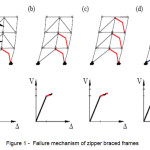 |
|
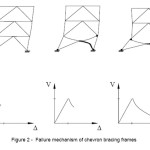 |
|
In order to reduce the chance of formation of soft story and obtain stable non-elastic seismic responses with chevron frames (figure 3) it is recommended to add a zipper column to the junction between braces and the beam. The zipper column is added to chevron bracing frames to cause simultaneous buckling of all compressive braces and yielding of all tensile braces. As a result, a large amount of energy is wasted.
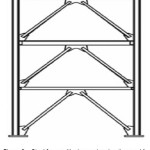 |
|
An Introduction to Zipper Braced Frames
In 1988, in order to address the seismic defect of chevron braces (inverse V) and prevent formation of soft story, Khatib et al.[1] recommended to use zipper columns (figure 4) Zipper columns are attached vertically and lie perpendicular (90 degrees) to floor beams. These columns can transfer the unbalancing force caused by the buckling of the compressive member of the first-story bracing to the bracings in upper stories (figure 5). As a result, compressive braces demonstrate buckling and tensile braces flow. This leads to the development of an overall failure mechanism in all braces prior to structural collapse. In 2004, Yang.[2] introduced the concept of suspended zipper frames (figure 6). In order to create such frames, the bracing members of the roof are designed to remain elastic following the buckling and yielding of all bracing members. In 2007, Yang suggested to prevent the buckling of roof bracings by multiplying the roof floor lateral force (that is equivalent to earthquake force) by two.
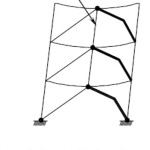 |
|
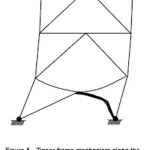 |
|
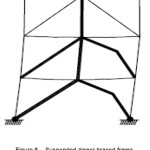 |
|
Analysis of the Drift Performance of Zipper Frames
According to previous studies[3], distribution of inter-story drift with zipper braced frames is uniform at height unlike chevron bracing frames. One of the disadvantages of chevron bracing frames is the uncontrolled increase in inter-story drifts at higher stories, especially high-rise structures. Since this problem does not exist with zipper frames, it can be concluded that zipper frames are proper substitutes for chevron frames. In areas with high seismicity, in order to control lateral inter-story drifts caused by chevron bracing frames, it is possible to use zipper braced frames. Based on research findings, the acceptable height for the use of zipper braced frames is 54 meters (app. 15 stories).
Analysis of the Ductility Performance of Zipper Frames
According to previous studies [4], ductility is the ability of the constituent parts, materials, connected parts or structures to bear non-elastic deformations with acceptable stiffness reduction and strength. Due to some economic reasons, many structures are designed to show non-elastic behavior under strong earthquakes. The response spectra of earthquake vibrations depend on the level of energy dissipation in structures. Energy dissipation in structures is also a function of their ability to absorb and waste energy through ductile deformations. Structures with smaller section areas demonstrate more ductility because maximum deformation produces a large energy dissipation capacity. Therefore, the level of ductility of larger areas is slight, rigidity coefficients are larger, and energy dissipation capacity is insignificant. The zipper braced system provides the highest level of capacity and ductility.
The seismic weakness of concentrically braced frames is the decrease in their compressive strength following the first buckling. There are two important dimensions to the behavior of bracings energy absorption/dissipation capacity; ductility and failure behavior.
Analysis of the Performance of Regular and Irregular Zipper Braced Frames
According to previous studies[5], the absorption and dissipation of energy is zipper braced frames is higher than in chevron frames. The level of energy absorption and dissipation in regular zipper frames is also higher than irregular frames. With an increase in height, the difference between the energy absorption of zipper braced systems and chevron bracing systems using regular and irregular frames declines. In low-rise structures, the drift caused by irregular frames is smaller than regular frames. However, with an increase in height the proportions change and the drift in regular frames declines. The level of energy absorption/dissipation by regular frames is higher in far-field areas than near-field areas.
Analysis of the Behavior Factor of Zipper Frames
Research results suggest [6] that behavior factor declines with an increase in the number of stories. Moreover, behavior factor is a function of the main oscillation period and loads acting on the structure. The elastic behaviors of chevron and zipper frames are similar because in linear conditions the zipper column has no function. Ductility, over-strength factor, and ductility coefficient of zipper braced frames are higher chevron frames because zipper frames result in larger roof drifts on the brink of failure compared to chevron frames. The behavior factor of zipper frames is also always larger than that of chevron frames. The proposed behavior factor for special concentrically braced frames (with special ductility) is 6 (R=6) in the appropriate codes of practice. This, however, is an underestimation for high-rise structures. Calculation results suggest that the behavior factors for zipper braced frames and chevron bracing frames are app. 5.62 and 4.38, respectively. An increase in the number of stories of structures with concentrically braced frames leads to a decrease in the ductility and behavior factor of the structure. In other words, the use of these frames is limited to some certain heights and hybrid systems shall be used with an increase in the number of stories.
Major Drawbacks of Zipper Braced Frames
The major disadvantage of zipper braced frames is that with an increase in the number of stories the dimensions of the sections of braces used in the highest floor grow to preserve their elastic function. This is one of the biggest disadvantages of this bracing system. Some other drawbacks of this bracing system include the following:
- Height-dependent changes in seismic behavior
- Unknown order of activation of the soft story mechanism of braces along the bracing frame’s height
- Unknown responses to different modes leading to a lack of knowledge about the type of the forces induced in the zipper column (either compressive or tensile force)
As a result of these factors, the number of stories and minimum strength of bracing members are the constraints on the use of this system.
Conclusion
- Due to the concentration of forces on one particular story, CBF frames are prone to the formation of soft story. Therefore, the best solution for seismic rehabilitation of chevron frames is the use of a zipper column that has to be turned into a zipper frame.
- In zipper braced frames, the simultaneous buckling of all bracings along the building height leads to uniform distribution of failure and damage in the structure.
- The zipper column demonstrates a compressive or tensile behavior depending on the location of the first buckled bracing. If the first bracing is located in the lowest floor, the zipper column shows a tensile behavior. However, when the buckled bracing is in the highest floor, the zipper column demonstrates compressive behavior.
- An increase in the bracing frame’s span length effectively enhances the seismic performance of the zipper braced frame.
- The behavior factor proposed in the appropriate codes for SCBFs (R=6) is not conservative compared to the resulting behavior factor (5.62) especially for high-rise structures.
- The amount of energy absorption and dissipation in zipper braced frames is more than chevron bracing frames.
- Unlike chevron bracing frames, distribution of inter-story drift over the structure height is uniform using zipper braced frames.
References
- khatib, I.F., Mahin, S.A., and Pister, k.s. Seismic behavior of concentrically steel frames. Report NO. UCB/EERC-88/01. BERKELY: Earthquake engineering research center. University of California,(1988)
- Yang C., Ph.D. thesis: Analytical and experimental study of concentrically braced frames with zipper struts,(2008)
- Razavi, Mojtaba, Sheidayi, Muhammadreza, and Tariverdiloo, Saeed. Improving the seismic behavior of chevron bracing frames using zipper elements. M.A. thesis, Urmia University, Urmia,(2010)
- Shiravand, Ahmad ,Seismic assessment of reinforced concrete frames strengthened using new steel braces. The first national conference on materials and new structures in civil engineering, University of Industrial High Tech and Higher Education, (February 2013)
- Amini, Mehran and Alirezayi, Mahdi (2013). Assessing the nonlinear behavior of regular and irregular zipper braced frames against chevron bracing frames. Civil engineering and architecture international conference, Islamic Azad University of Tabriz, (February 2014)
- Razabi, Mojtaba, Sheidayi, Muhammadreza, and Tariverdiloo, Saeed. Calculating the behavior factor of zipper braced frames. M.A. thesis, Urmia University, Urmia,(2010)







